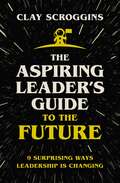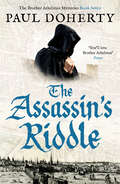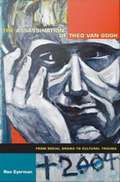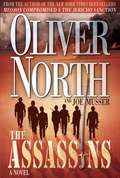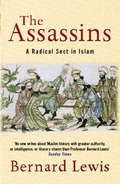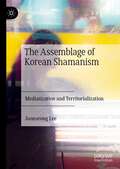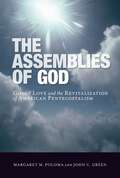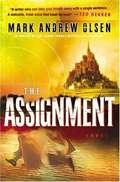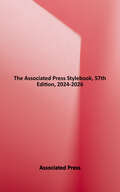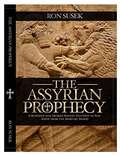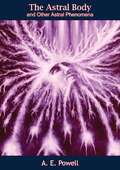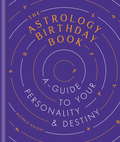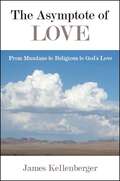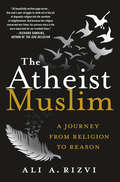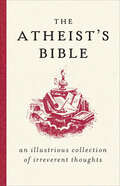- Table View
- List View
The Aspiring Leader's Guide to the Future: 9 Surprising Ways Leadership is Changing
by Clay ScrogginsYou may not hold a position of leadership or think of yourself as a leader. But if you want to create, change, or impact the world around you—even in a modest way—then you're guided by a leader's impulse and shaped by a leader's principles.You are an aspiring leader.But the fact is that you've come to this role at a time when leadership—like everything else—is rapidly changing...and too many leaders are addressing the problems of today and tomorrow with the style and substance of yesterday's leadership. We need an update.In The Aspiring Leader's Guide to the Future, Clay Scroggins (author of How to Lead When You're Not in Charge) explores nine new principles of leadership that will help leaders adapt to a changing world and work culture, such as:Today's leaders lean into vulnerability.Today's leaders develop relationships primarily around trust.Today's leaders celebrate the successes of others.These may seem like counter-intuitive principles, but they provide a new way forward for leaders and teams and will prove versatile in the event of change and durable in the face of conflict. With humor and a pastor's candor, Clay will show you why the old ways need updating and what developing new leadership skills could look like for your future.To be clear, the author of this book does not know the future. If he did, he would have used his talents on sports betting or stock trading. What he does know is that yesterday's leadership axioms are today's myths and what that means. The way forward requires an understanding of the past, a conviction of what's at stake today, and a vision for how different tomorrow will be.You don't have to be a young entrepreneur with big dreams or someone looking to land a leadership role just to be considered an aspiring leader. You are one now. And by developing your skills for the future, you can become today's version of a leader worth following.
The Assassin's Riddle (Brother Athelstan Mysteries)
by Paul DohertyThe only way to win this murderer’s deadly game… is to play along.Summer, 1380. Brutal and sudden death is not uncommon in the foul alleys and streets of London. The corpse of a clerk has been pulled from the Thames. They drowned, but not before receiving a vicious blow to the back of the head.Then Bartholomew Drayton, a usurer and money-lender, is found dead in his strongroom, a crossbow bolt firmly embedded in his chest: a real mystery because the windowless strongroom was locked and barred from the inside. So who killed him? And how? And are the deaths connected?Sir John Cranston comes to survey the scene. When other clerks are murdered, each with a riddle pinned to his corpse, Cranston enlists the help of Brother Athelstan – and together they must pit their wits against a deadly adversary bent on murder and mayhem.Another thrilling historical mystery from a true master of the genre, perfect for fans of S. G. MacLean, S. J. Parris and C. J. Sansom.
The Assassination of Theo Van Gogh: From Social Drama to Cultural Trauma
by Ron EyermanIn November 2004, the controversial Dutch filmmaker Theo van Gogh was killed on a busy street in Amsterdam. A twenty-six-year-old Dutch citizen of Moroccan descent shot van Gogh, slit his throat, and pinned a five-page indictment of Western society to his body. The murder set off a series of reactions, including arson against Muslim schools and mosques. In The Assassination of Theo van Gogh, Ron Eyerman explores the multiple meanings of the murder and the different reactions it elicited: among the Amsterdam-based artistic and intellectual subculture, the wider Dutch public, the local and international Muslim communities, the radical Islamic movement, and the broader international community. After meticulously analyzing the actions and reputations of van Gogh and others in his milieu, the motives of the murderer, and the details of the assassination itself, Eyerman considers the various narrative frames the mass media used to characterize the killing. Eyerman utilizes theories of social drama and cultural trauma to evaluate the reactions to and effects of the murder. A social drama is triggered by a public transgression of taken-for-granted norms; one that threatens the collective identity of a society may develop into a cultural trauma. Eyerman contends that the assassination of Theo van Gogh quickly became a cultural trauma because it resonated powerfully with the postwar psyche of the Netherlands. As part of his analysis of the murder and reactions to it, he discusses significant aspects of twentieth-century Dutch history, including the country's treatment of Jews during the German occupation, the loss of its colonies in the wake of World War II, its recruitment of immigrant workers, and the failure of Dutch troops to protect Muslims in Srebrenica in 1995.
The Assassins: A Novel
by Oliver L. North Joe MusserThis book follows: The Jericho Sanction. Years after the September 11 th attacks on America, the world awakes one morning to the news that Islamic Jihadists have assailed multiple targets in Saudi Arabia, destroying oil-pumping equipment, crippling pipelines, and assassinating most of the royal family. Inflation rocks the world's financial markets. The normal rules no longer apply. In a closed session of Congress an "Assassination Bill" is introduced. General Peter Newman is assigned to head a new "Threat Mitigation Unit," and he is given authority to recruit and train up to 100 specialists for the ominous task at hand-to assassinate terrorists. Soon, intelligence shows Iranians are planning to attack America, and as Newman and his team are dispatched, a chase around the world ensues. But the enemy's backup plan involves hijacked airplanes with nuclear weapons targeting najor American cities.
The Assassins: A Radical Sect in Islam
by Bernard LewisThe history of an extremist Islamic sect in the 11th-12th centuries whose terrorist methods gave the English language a new word: assassin.The word 'Assassin' was brought back from Syria by the Crusaders, and in time acquired the meaning of murderer. Originally it was applied to the members of a Muslim religious sect - a branch of the Ismailis, and the followers of a leader known as the Old Man of the Mountain. Their beliefs and their methods made them a by-word for both fanaticism and terrorism in Syria and Persia in the 11th and 12th centuries, and the subject of a luxuriant growth of myth and legend.In this book, Bernard Lewis begins by tracing the development of these legends in medieval and modern Europe and the gradual percolation of accurate knowledge concerning the Ismailis. He then examines the origins and activities of the sect, on the basis of contemporary Persian and Arabic sources, and against the background of Middle Eastern and Islamic history. In a final chapter he discusses some of the political, social and economic implications of the Ismailis, and examines the significance of the Assassins in the history of revolutionary and terrorist movements.
The Assassins: A Radical Sect in Islam
by Bernard LewisThe history of an extremist Islamic sect in the 11th-12th centuries whose terrorist methods gave the English language a new word: assassin.The word 'Assassin' was brought back from Syria by the Crusaders, and in time acquired the meaning of murderer. Originally it was applied to the members of a Muslim religious sect - a branch of the Ismailis, and the followers of a leader known as the Old Man of the Mountain. Their beliefs and their methods made them a by-word for both fanaticism and terrorism in Syria and Persia in the 11th and 12th centuries, and the subject of a luxuriant growth of myth and legend.In this book, Bernard Lewis begins by tracing the development of these legends in medieval and modern Europe and the gradual percolation of accurate knowledge concerning the Ismailis. He then examines the origins and activities of the sect, on the basis of contemporary Persian and Arabic sources, and against the background of Middle Eastern and Islamic history. In a final chapter he discusses some of the political, social and economic implications of the Ismailis, and examines the significance of the Assassins in the history of revolutionary and terrorist movements.
The Assault on Reason: How the Politics of Blind Faith Subvert Wise Decision-making
by Al GoreA visionary analysis of how the politics of fear, secrecy, cronyism, and blind faith have combined with the degradation of the public sphere to create an environment hostile to reason
The Assemblage of Korean Shamanism: Mediatization and Territorialization
by Joonseong LeeThe most unique aspect of Korean shamanism is its mysterious duality that continually reiterates the processes of deterritorialization and reterritorialization. This book approaches that puzzle of mysterious duality using an interdisciplinary lens. Korean shamanism has been under continuous oppression and marginalization for a long time, and that circumstance has never dissipated. Shaman culture can be found in every corner of people’s lives in contemporary Korea, but few acknowledge their indigenous beliefs with pride. This mysterious duality has deepened as the mediatization process of Korean shamanism has developed. Korean shamanism was revived as the dynamic of shamanic inheritance in the process, but these dynamics have also become the object of mockery. For this reason, any true understanding of Korean shamanism rests in how to unravel the unique puzzles of this mysterious duality. In this book, the duality is mapped out by playing with the puzzles surrounding the contextualization of Korean shamanism and mediatization.
The Assemblies of God: Godly Love and the Revitalization of American Pentecostalism
by Margaret M. Poloma John C. GreenThe Assemblies of God (AG) is the ninth largest American and the world’s largest Pentecostal denomination, with over 50 million followers worldwide. The AG embraces a worldview of miracles and mystery that makes“supernatural” experiences, such as speaking in tongues, healing, and prophecy, normal for Christian believers. Ever since it first organized in 1916, however, the “charismata” or “gifts of the Holy Spirit” have felt tension from institutional forces. Over the decades, vital charismatic experiences have been increasingly tamed by rituals, doctrine, and denominational structure. Yet the path towards institutionalization has not been clear-cut. New revivals and direct personal experience of God—the hallmarks of Pentecostalism—continue as an important part of the AG tradition, particularly in the growing number of ethnic congregations in the United States.The Assemblies of God draws on fresh, up-to-date research including quantitative surveys and interviews from twenty-two diverse Assemblies of God congregations to offer a new sociological portrait of the AG for the new millennium. The authors suggest that there is indeed a potential revitalization of the movement in the works within the context of the larger global Pentecostal upswing, and that this revitalization may be spurred by what the authors call “godly love:” the dynamic interaction between divine and human love that enlivens and expands benevolence.The volume provides a wealth of data about how the second-largest American Pentecostal denomination sees itself today, and suggests trends to illuminate where it is headed in the future.
The Assignment
by Mark Andrew Olsen[This quote is taken from the back cover of the book.] "Follow a disillusioned young priest, a terrified graduate student, and a spiritually fascinating man--from the shores of Normandy to the hills of Ireland, from the alleyways of Paris, Rome, and Jerusalem, to the halls of time itself--in a suspenseful thriller that combines the supernatural with unrelenting action, aching loss, and one life story that will sweep you to the very foot of Golgotha."
The Associated Press Stylebook, 57th Edition, 2024-2026
by Associated PressThe spiral-bound Associated Press Stylebook, 57th Edition, includes new chapters on artificial intelligence and criminal justice and a detailed self-editing checklist. Specialized chapters cover sports, business, punctuation, religion, data journalism, inclusive storytelling, health and science, news values, and polls and surveys.
The Assurance of Salvation: Biblical Hope for Our Struggles
by ZondervanFor years, Robert A. Peterson taught about the assurance of salvation in seminary and Sunday school classrooms. He was concerned, however, to find that some people who, for a variety of reasons, were unable to grasp the certainty of their salvation. The Assurance of Salvation identifies these "troublers" of assurance and provides the remedy to diffuse insecurity.Peterson asserts that difficult backgrounds and experiences, intellectual doubts, tender consciences, habitual sins, and overconfidence that people face are the enemies of assurance. Through a competent handling of the Bible, he explains that by embracing three gifts from God--His Word, His Spirit, and His work in our lives--those who struggle with insecurity are able to personally experience the freedom of God's assurance.
The Assyrian Prophecy
by Ron SusekA betrayed and broken nation destined to rise anew from the Martyr's blood.
The Astadhyayi of Panini Volume III
by J. A. F. Roodbergen S. D. JoshiTranslation in English of Indian history, religion and culture, volume 3.
The Astadhyayi of Panini Volume IV
by J. A. F. Roodbergen S. D. JoshiTranslation in English of Indian history, religion and culture, 4th volume.
The Astadhyayi of Panini Volume XIII
by J. A. F. Roodbergen S. D. JoshiTranslation in English of Indian history, religion and culture, volume 13.
The Astonishing Hypothesis: The Scientific Search for the Soul
by Francis CrickNobel Laureate Francis Crick boldly stradles the line between science and spirituality by examining the soul from the standpoint of a modern scientist.
The Astral Body and Other Astral Phenomena: And Other Astral Phenomena (Quest Book Ser.)
by A. E. PowellTHE purpose of this book is to present to the student of Theosophy a condensed synthesis of the information at present (1926) available concerning the Astral Body of man, together with a description and explanation of the astral world and its phenomena. The book is thus a natural sequel of The Etheric Double and Allied Phenomena published in 1925.As in the case of The Etheric Double, the compiler has consolidated the information obtained from a large number of books, a list of which is given, arranging the material, which covers a vast field and is exceedingly complex, as methodically as lay within his power. It is hoped that by this means present and future students of the subject will be saved much labour and research, being able not only to find the information they require presented in a comparatively small compass, but also, with the help of the marginal references, to refer, should they so desire, to the original sources of information.In order that the book may fulfil its purpose by being kept within reasonable dimensions, the general plan followed has been to expound the principles under-lying astral phenomena, omitting particular examples or instances. Lecturers and others who wish specific illustrations of the principles enunciated, will find the marginal references useful as a clue to the places where the examples they seek may be found.—A. E. Powell
The Astrological Goetia: The 72 Keys to Angelic and Demonic Astrology
by Jaime Paul Lamb• Details an astrological system based on the 72 Qabalistic angels of the Sefer Raziel, the 72 Solomonic demons of the Ars Goetia, and the 72 quinaries of the zodiac• Discusses the angels of the Shem HaMephorash and the Qabalistic lore surrounding them, the demons of the Ars Goetia and their origin in the Solomonic grimoire tradition, and how each demon is paired with its corresponding angel• Explains the astrological meanings, significations, attributes, sigils, and seals of the 72 angels and their demon counterparts as well as how to apply these 72 quinarian keys of occult astrology to your own practiceBlending zodiacal divination with Qabalistic magic and Solomonic demons, Jaime Paul Lamb details a system of occult astrology based on ancient texts. He discusses the angels of the Shem HaMephorash and the qabalistic lore surrounding them, the demons of the Ars Goetia and their origin in the Solomonic grimoire tradition, and how each demon is paired with a specific angel. He details the astrological meanings, significations, attributes, sigils, and seals of the 72 angels and their demon counterparts.The author shows how the 72 Shem HaMephorash angels from the medieval Sefer Raziel HaMalakh and their corresponding 72 demons from the Ars Goetia (a Solomonic grimoire) are each associated with a specific 5-degree arc of the zodiac, with one angel-demon pair, or quinary, per segment. With 30 degrees in each astrological sign, there are thus 6 angel-demon quinaries for each sign, each providing new insights for understanding personality and fate. He examines the zodiac degrees ruled by each angel and demon and explains how the quinaries influence the planets within the 5 degrees that they rule.Providing the historical, theoretical, and practical tools necessary to apply these 72 quinarian keys of occult astrology, Lamb&’s guide allows astrologers to interpret individuals&’ charts with greater subtlety and depth while simultaneously enhancing their own magical practice.
The Astrology Birthday Book
by Michelle KnightEver wondered how your date of birth influences your personality, your loves and passions, and your path in life? The Astrology Birthday Book reveals how the precise alignment of the planets on your date of birth determines the characteristics that make you unique.
The Asymptote of Love: From Mundane to Religious to God's Love
by James KellenbergerIn The Asymptote of Love, James Kellenberger develops a theory of religious love that resists essentialist definitions of the term and brings into conversation historical debates on love in Western philosophy and Christian theology. He argues that if love can be likened to a mathematical asymptote, which is a straight line that infinitely approaches a curve but never quite reaches it, then the asymptote of love reaches toward the infinite endpoint of love at its uttermost, namely, God's love. Drawing upon a broad range of thinkers who have put forth classic debates on love—such as St. Augustine of Hippo, Anders Nygren, and St. Thomas Aquinas, as well as some lesser known figures in the debate, such as Leo Tolstoy and Albert Schweitzer—Kellenberger explains the profound connection between human agape and God's infinite love in its capacity to offer both directive guidance and to exist beyond human conception.
The Atheist Muslim: A Journey from Religion to Reason
by Ali A. RizviIn much of the Muslim world, religion is the central foundation upon which family, community, morality, and identity are built. The inextricable embedment of religion in Muslim culture has forced a new generation of non-believing Muslims to face the heavy costs of abandoning their parents' religion: disowned by their families, marginalized from their communities, imprisoned, or even sentenced to death by their governments. Struggling to reconcile the Muslim society he was living in as a scientist and physician and the religion he was being raised in, Ali A. Rizvi eventually loses his faith. Discovering that he is not alone, he moves to North America and promises to use his new freedom of speech to represent the voices that are usually quashed before reaching the mainstream media--the Atheist Muslim.In The Atheist Muslim, we follow Rizvi as he finds himself caught between two narrative voices he cannot relate to: extreme Islam and anti-Muslim bigotry in a post-9/11 world. The Atheist Muslim recounts the journey that allows Rizvi to criticize Islam--as one should be able to criticize any set of ideas--without demonizing his entire people. Emotionally and intellectually compelling, his personal story outlines the challenges of modern Islam and the factors that could help lead it toward a substantive, progressive reformation.
The Atheist's Bible: An Illustrious Collection of Irreverent Thoughts
by Joan KonnerA wise and witty collection of quips, quotes, and musings from the world’s greatest geniuses and jokers, proving that “all thinking men are atheists” (Ernest Hemingway)From Sophocles to Homer Simpson, The Atheist’s Bible celebrates the long and rich tradition of rejecting organized religion. Included here are insights and observations from scientists, writers, philosophers, and comedians throughout history who have questioned the wisdom (and sanity) of pious believers. Far from a cynical polemic, this “bible” shares the same joy, love of beauty, and human wonder that religious books of quotations provide, but with a healthy dose of independent thought and without dogma.
The Atheist's Bible: The Most Dangerous Book That Never Existed
by Georges MinoisThis intellectual history of a rumored book of heresy reveals a persistent undercurrent of atheism from the Middle Ages into the 18th century. In 1239, Pope Gregory IX accused Frederick II, the Holy Roman Emperor, of heresy. Without disclosing evidence of any kind, Gregory announced that Frederick had written a supremely blasphemous book—De tribus impostoribus, or the Treatise of the Three Impostors—in which Frederick denounced Moses, Jesus, and Muhammad as impostors. Of course, Frederick denied the charge, and over the following centuries the story played out across Europe, with libertines, freethinkers, and other &“strong minds&” seeking a copy of the scandalous text. The fascination persisted until finally, in the eighteenth century, someone brought the purported work into actual existence—in not one but two versions, Latin and French. Although historians have debated the origins and influences of this most apocryphal book, there has not been a comprehensive biography of the Treatise of the Three Impostors. In The Atheist&’s Bible, historian Georges Minois tracks the course of the book from its origins in 1239 to its most salient episodes in the seventeenth and eighteenth centuries, introducing readers to the colorful individuals obsessed with possessing the legendary work—and the equally obsessive passion of those who wanted to punish people who sought it. Minois&’s compelling account sheds much-needed light on the power of atheism, the threat of blasphemy, and the persistence of free thought during a time when the outspoken risked being burned at the stake. &“[A] timely and elegant study…Readers who are intrigued or scandalized by the diatribes of Richard Dawkins or Christopher Hitchens will discover in The Atheist&’s Bible that, as that other Bible says, there is nothing new under the sun.&”—Walter Stephens, author of Demon Lovers
The Atheist's Creed
by Michael PalmerIn The Atheist's Creed a prominent and widely-read contemporary philosopher, Dr Michael Palmer, presents the most comprehensive anthology of the major philosophical arguments for atheism now before the public. While the so-called 'new atheism' of RichardDawkins and others has attracted considerable publicity, it is these philosophical arguments that have down the ages provided the principal landmarks in the unfolding and increasingly widespread belief that no God exists. Using a combination of extracts,detailed introductions, biographies and extensive bibliographies, the author guides the reader through the history of atheism, from the time of the early Greeks down to the present day. In this analysis particular attention is given to the writings of Hume, Nietzsche, Marx and Freud. The Atheist's Creed requires no specialist knowledge of philosophy. Each chapter is structured around a single theme and the various authors coordinated to allow the full force of the particular atheistic argument to emerge.The result is a compelling and powerful assessment of the case for atheism, which will be essential and fascinating reading for student and non-student alike and for all those concerned with the fundamental question: whether or not there is a God.
